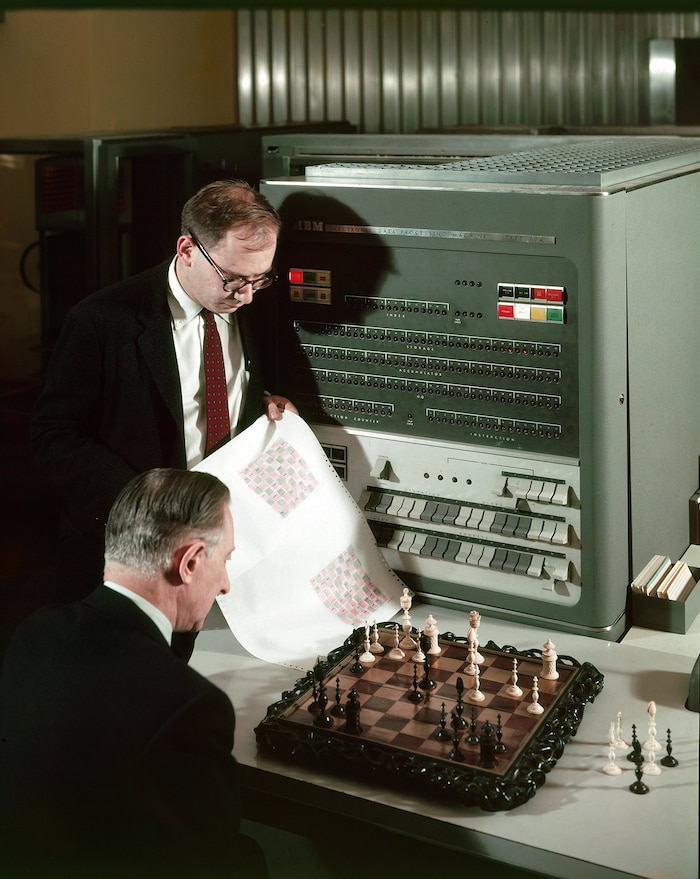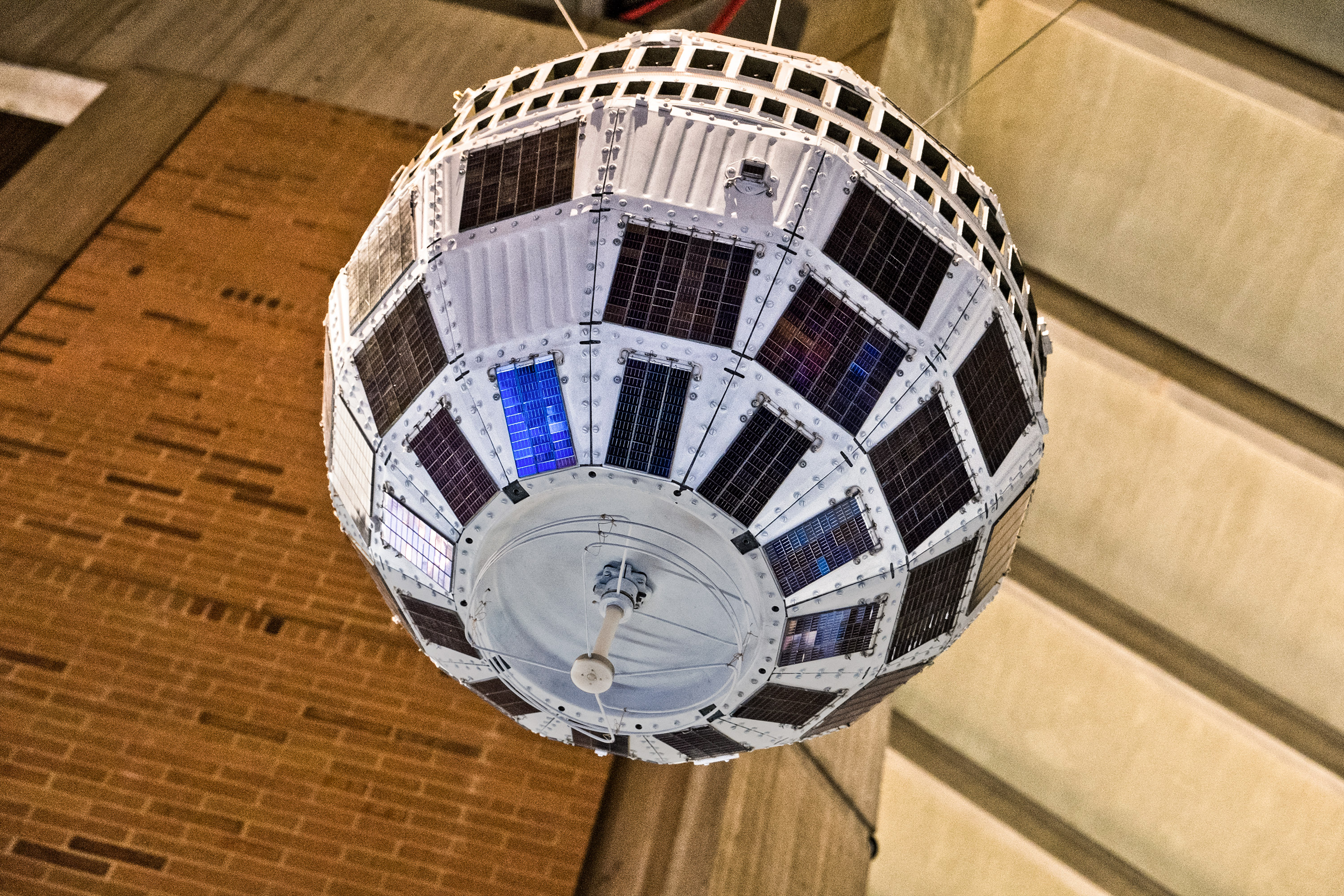The Music of Bell Labs
The pioneering company, Geeta Dayal writes, inspired its employees to create some of the first examples of computer music

In the 1950s, Bell Labs was at the height of its powers – a singular and peculiar American institution that seemed to have a hand in every major scientific discovery of the 20th century. Researchers at Bell Labs had discovered the transistor, launched the field of information theory, invented the photovoltaic cell and built the first digitally scrambled speech transmission system, among other things.
Bell Labs was simultaneously becoming an unlikely center for pioneering computer music, art, film and animation. In the 1960s and 1970s, prominent composers such as John Cage, James Tenney and Edgard Varèse would visit Bell Labs to work on ideas. In the 1970s, Laurie Spiegel came to Bell Labs, where she made her classic album The Expanding Universe. Max Mathews, the long-time director of acoustics at Bell Labs and the father of computer music, was at the heart of Bell Labs’ computer music effort, beginning in the 1950s. Billy Klüver, another Bell Labs engineer, helmed E.A.T. and Nine Evenings: Theater and Engineering, which legendarily paired artists and musicians with engineers at the Armory in New York.
While scientists used an IBM 704 to calculate the position of Sputnik, Max Mathews used the same computer to compose melodies.
“Bell Labs was a golden era,” Max Mathews told me shortly before his death in 2011. “Golden for several things. One was that the research money to support it was gotten as a tax on the earnings or the profits of the telephone companies. We got it as a lump sum. The vice president in charge of research, William O. Baker, insisted that there be no strings attached to the money and that we could use it in the way we thought was best.”
At Bell Labs, researchers could pursue their interests. Their achievements were even more impressive considering that early computers were massive, lumbering creatures. The IBM 704, the first mass-produced supercomputer, retailed for $1.2 million and boasted a maximum speed of one-tenth of a megahertz. The operating manual, circa 1954, referred to the labyrinthine complex of interconnected devices as a “large-scale, high-speed electronic calculator.”
The computer was originally intended for scientific use – this, of course, meant military applications in the paranoid years following World War II. At MIT, for instance, teams of scientists worked covertly on these machines, using them to calculate missile trajectories in Building 20, the crumbling edifice where radar was developed ten years prior.
By 1956, a scientist in Poughkeepsie named Arthur Samuel had taught an IBM 701, a behemoth nicknamed the “Defense Calculator,” how to play checkers. IBM trumpeted the innovation, which put a friendly face on a sinister-looking machine designed for the military-industrial complex, and put Samuel and his checkers on national television. In 1957, while scientists at MIT frantically used an IBM 704 to calculate the position of Sputnik – launched into orbit that year by the Russians, to the great dismay of President Eisenhower – Mathews used the same computer to compose melodies. After many months of late-night experimentation, Mathews successfully coaxed the IBM 704 into generating 17 seconds of sound, laying the groundwork for the field of computer music.
The violin is certainly beautiful, but it will always sound like a violin.
Mathews had done his doctoral work at MIT in the early 1950s, where he worked on missile guidance systems in Building 20 using an analog computer that was made out of glass and wood and weighed several tons. In 1954, Mathews left MIT for a job at Bell Telephone Laboratories, excited by the prospect of working on acoustics instead of missile guidance systems.
Mathews’ boss at Bell Labs was John Pierce, who coined the word “transistor” and developed the first global communications satellites. Pierce loved music and science fiction, writing songs and stories in his spare time and counting Isaac Asimov and Arthur C. Clarke among his friends. Eventually, Pierce encouraged Mathews to take time off from his work with acoustics to explore the strange new world of computer music.
Mathews was a visionary who saw the potential in those early computers to create new sounds. “We knew at the beginning that the computer could make any sound the human ear could hear, and any timbre,” Mathews told me. “That was not true of traditional instruments. The violin is certainly beautiful, but it will always sound like a violin. That can be very good, and it’s also limited. And the computer is not limited.”

Mathews worked longer and harder at Bell Labs instead of taking time off. After the official workday ended, he stayed in his laboratory to write a computer program in machine language that he called MUSIC: the first software to synthesize sound on a computer. Sometimes, when he felt tired and a bit mischievous, he would pipe the results of his nascent sonic experiments through the entire intercom system at Bell Labs. While Mathews toiled through the night to teach the ungainly IBM 704 how to make music, his colleagues down the hall were busy inventing a device they called the laser.
By 1962, the IBM 704 had given way to the IBM 7094, IBM’s most powerful computer at that time. The colossal machine, which retailed for a whopping $3.1 million, operated at 0.5 megahertz and had 32 kilobytes of memory. Only the biggest universities, like MIT and the University of Michigan, had access to the cutting-edge machine. Bell Labs got one, too; they got one of everything. Mathews and a team of fellow acoustics researchers worked to teach the IBM 7094 how to sing.
By this point, he was leading the entire acoustics research group at Bell Labs. In 1963, the prestigious journal Science published an article by Mathews titled “The Digital Computer as a Musical Instrument,” connecting the work of Claude Shannon and Harry Nyquist, two legendary scientists who worked at Bell Labs, to music. “There are no theoretical limitations to the performance of the computer as a source of musical sounds,” Mathews proclaimed in his article, inspiring a legion of budding computer music researchers around the world.
In the late 1960s, Stanley Kubrick sent one of his people to Bell Labs to figure out what a telephone booth in space should be like. “Baker, the vice-president of research, sent the guy to talk to John Pierce, my boss,” Mathews told me. “Pierce gave his opinions on the telephone booth, and then said to go hear some of my computer music. He came, and I had this first piece that had a singing voice synthesized, ‘A Bicycle Built for Two’, and the guy was impressed with that, and apparently Kubrick was impressed with it.”
“A Bicycle Built for Two,” created in collaboration with Bell Labs acoustic researcher Joan Miller, was Mathews’ first hit – as much of a hit as computer music could be in the 1960s. “They apparently incorporated it into the plot as HAL’s swan song,” Mathews said. “He didn’t actually use the tape that I sent him; he had an orchestra, or synthesizers, redo it.”
Later on, one of the most enduring pieces of computer music made at Bell Labs was Laurie Spiegel’s The Expanding Universe, which was made with a system called GROOVE (“Generated Real-Time Output Operations on Voltage-Controlled Equipment”) that was co-designed by Mathews. “‘The thing I wanted to listen to just wasn’t in my shelves of LPs – it was The Expanding Universe,” Spiegel told me. “Which then, as a do-it-yourself-er, I made it myself, which to do I had to learn FORTRAN and write all this code.”
Bell Labs still exists, in a far more modest form, as Alcatel-Lucent. The campus in Murray Hill, New Jersey still teems with researchers, but its far-reaching vision and seemingly endless cash flow – fueled by the former Bell telephone company monopoly – is a thing of the analog past. Still, we can revisit these glory days via the vast amount of art and music that was created within those walls.

